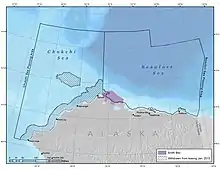Smith Bay
Smith Bay is an estuary in the Beaufort Sea that supports a wide range of fish, birds, and marine mammals. It is located northeast of Point Barrow, Alaska. The Bureau of Ocean Energy Management recognizes the southeastern portion of Barrow Canyon, which covers some, but not all, of Smith Bay, as an Environmentally Important Area.[1]

Geography
Approximately 150 miles west of Prudhoe Bay, Alaska, Smith Bay stretches from Dease Inlet, Alaska to Cape Halkett, Alaska. Bordered by barrier islands that separate the shallow, brackish waters from the Beaufort Sea, several slow-moving rivers flow into this region. Along with its adjacent waters, Smith Bay is a shallow-water estuary.
Fauna
Smith Bay is a significant hotspot for pinnipeds.[2] The nearshore areas are important habitat for ringed seals that come to the landfast ice during the winter and spring to give birth.[3]
Polar bears and bowhead whales rely on Smith Bay for important foraging habitat.[4][5] Polar bears have been observed using Smith Bay as a major maternal denning area to raise their young.[6]
Many species of birds, including yellow-billed loons, king eiders, Arctic terns, black-legged kittiwakes, glaucous and Sabine's gulls, king eiders, long-tailed ducks, and red phalaropes, are found in Smith Bay.[7]
Energy
There is a known oil seep at Cape Simpson on the western side of Smith Bay. In 2015 and 2016, Caelus Energy Alaska drilled two exploration wells in the southern part of the bay.[8] In October 2016, the company announced what it called a major oil discovery in the bay and said it would drill a third well in January 2018 and proceed with permitting a pipeline afterwards.[9]
References
- Bureau of Ocean Energy Management, "Outer Continental Shelf Oil and Gas Leasing Program: 2017-2022, Draft Programmatic Environmental Impact Statement", Bureau of Ocean Energy Management, 2016. Retrieved 22-09-2016.
- Kuletz K., Ferguson M., Hurley B., Gall A., Labunski E., and Morgan T., "Seasonal spatial patterns in seabird and marine mammal distribution in the eastern Chukchi and western Beaufort seas: Identifying biologically important pelagic areas", Progress in Oceanography, 2015. Retrieved 22-09-2016.
- Kelly B., Bengtson J., Boveng P., and Wilder M., "Status review of the ringed seal (Phoca hispida)", NOAA Technical Report, 2010. Retrieved 22-09-2016.
- Kalxdorff S., ["Colelction of local knowledge regarding polar bear habitat use in Alaska"], Technical Report, USFWS, 1997.
- Citta J., Quakenbush L., Okkonen S., Druckenmiller M., Maslowski W., Clement-Kinney J., George J., Brower H., Small R., Ashjian C., Harwood L., and Heide-Jorgensen M.,"Ecological characteristics of core-use areas used by Bering-Chukchi-Beaufort (BCB) bowhead whales, 2006-2012", Progress in Oceanography, 2015. Retrieved 22-09-2016.
- National Oceanic and Atmospheric Administration, ["Bering, Chukchi, and Beaufort Seas Coastal and Ocean Zones Strategic Assessment: Data Atlas"], NOAA, 1988.
- Smith M., Walker N., Free C., Kirchhoff M., Drew G., Warnock N., and Stenhouse I., "Identifying marine Important Bird Areas using at-sea survey data", Biological Conservation, 2014. Retrieved 22-09-2016.
- Bailey A., "Caelus hints at big find on North Slope", Alaska Dispatch News., 2016. Retrieved 22-09-2016.
- Gold, Russell (October 4, 2016). "Oil Explorer Claims Major Alaskan Find". Wall Street Journal. Retrieved October 4, 2016.